Leading Organizational Change
VerifiedAdded on 2020/11/23
|12
|3795
|186
Report
AI Summary
This assignment delves into the multifaceted process of leading organizational change. It requires a critical analysis of various change management theories and models, examining their application in diverse organizational contexts. Students are expected to evaluate the effectiveness of different leadership styles and strategies in driving successful change initiatives. The assignment also encourages students to draw upon real-world case studies, such as those involving Sainsbury's and ASDA, to illustrate the challenges and complexities inherent in leading organizational transformation.
Contribute Materials
Your contribution can guide someone’s learning journey. Share your
documents today.
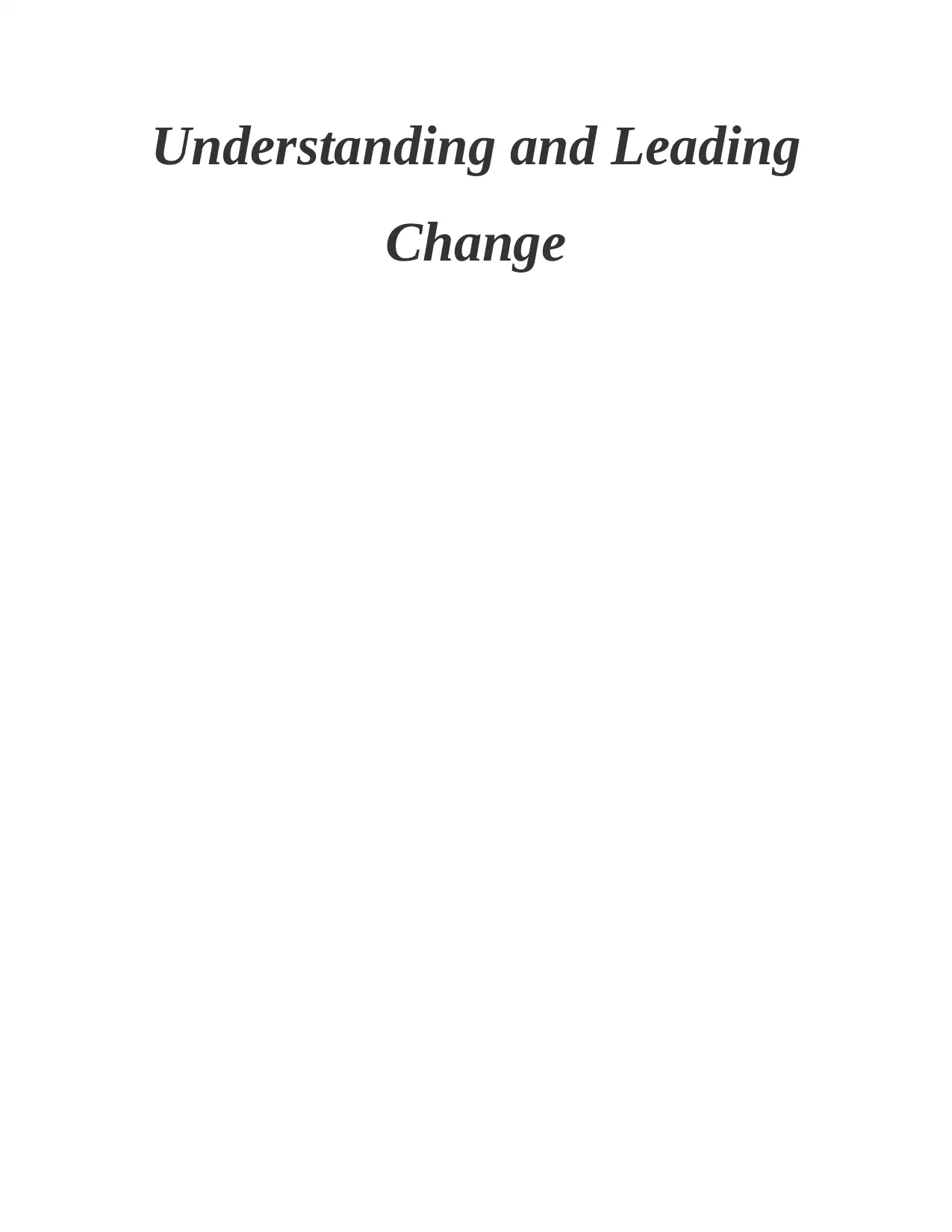
Understanding and Leading
Change
Change
Secure Best Marks with AI Grader
Need help grading? Try our AI Grader for instant feedback on your assignments.
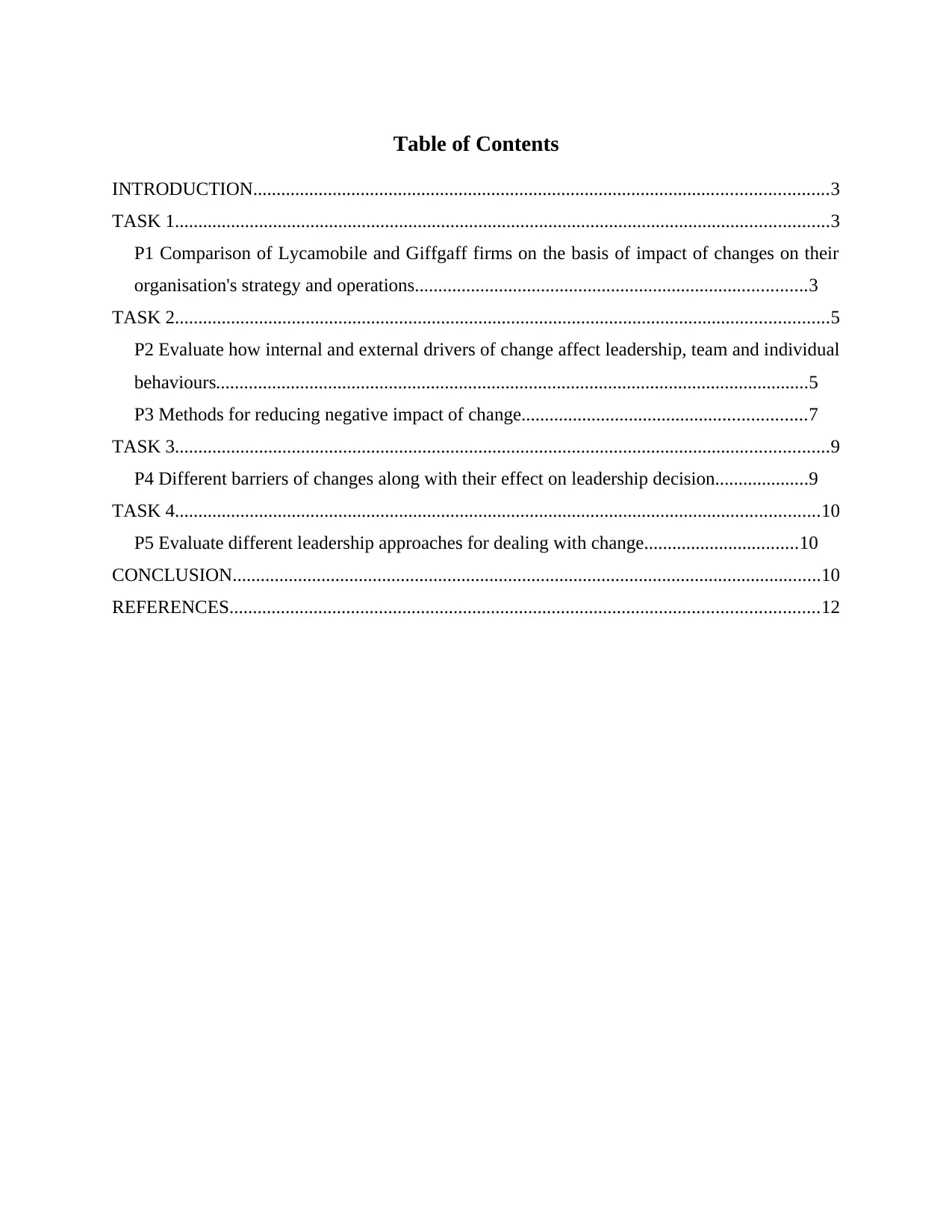
Table of Contents
INTRODUCTION...........................................................................................................................3
TASK 1............................................................................................................................................3
P1 Comparison of Lycamobile and Giffgaff firms on the basis of impact of changes on their
organisation's strategy and operations....................................................................................3
TASK 2............................................................................................................................................5
P2 Evaluate how internal and external drivers of change affect leadership, team and individual
behaviours...............................................................................................................................5
P3 Methods for reducing negative impact of change.............................................................7
TASK 3............................................................................................................................................9
P4 Different barriers of changes along with their effect on leadership decision....................9
TASK 4..........................................................................................................................................10
P5 Evaluate different leadership approaches for dealing with change.................................10
CONCLUSION..............................................................................................................................10
REFERENCES..............................................................................................................................12
INTRODUCTION...........................................................................................................................3
TASK 1............................................................................................................................................3
P1 Comparison of Lycamobile and Giffgaff firms on the basis of impact of changes on their
organisation's strategy and operations....................................................................................3
TASK 2............................................................................................................................................5
P2 Evaluate how internal and external drivers of change affect leadership, team and individual
behaviours...............................................................................................................................5
P3 Methods for reducing negative impact of change.............................................................7
TASK 3............................................................................................................................................9
P4 Different barriers of changes along with their effect on leadership decision....................9
TASK 4..........................................................................................................................................10
P5 Evaluate different leadership approaches for dealing with change.................................10
CONCLUSION..............................................................................................................................10
REFERENCES..............................................................................................................................12
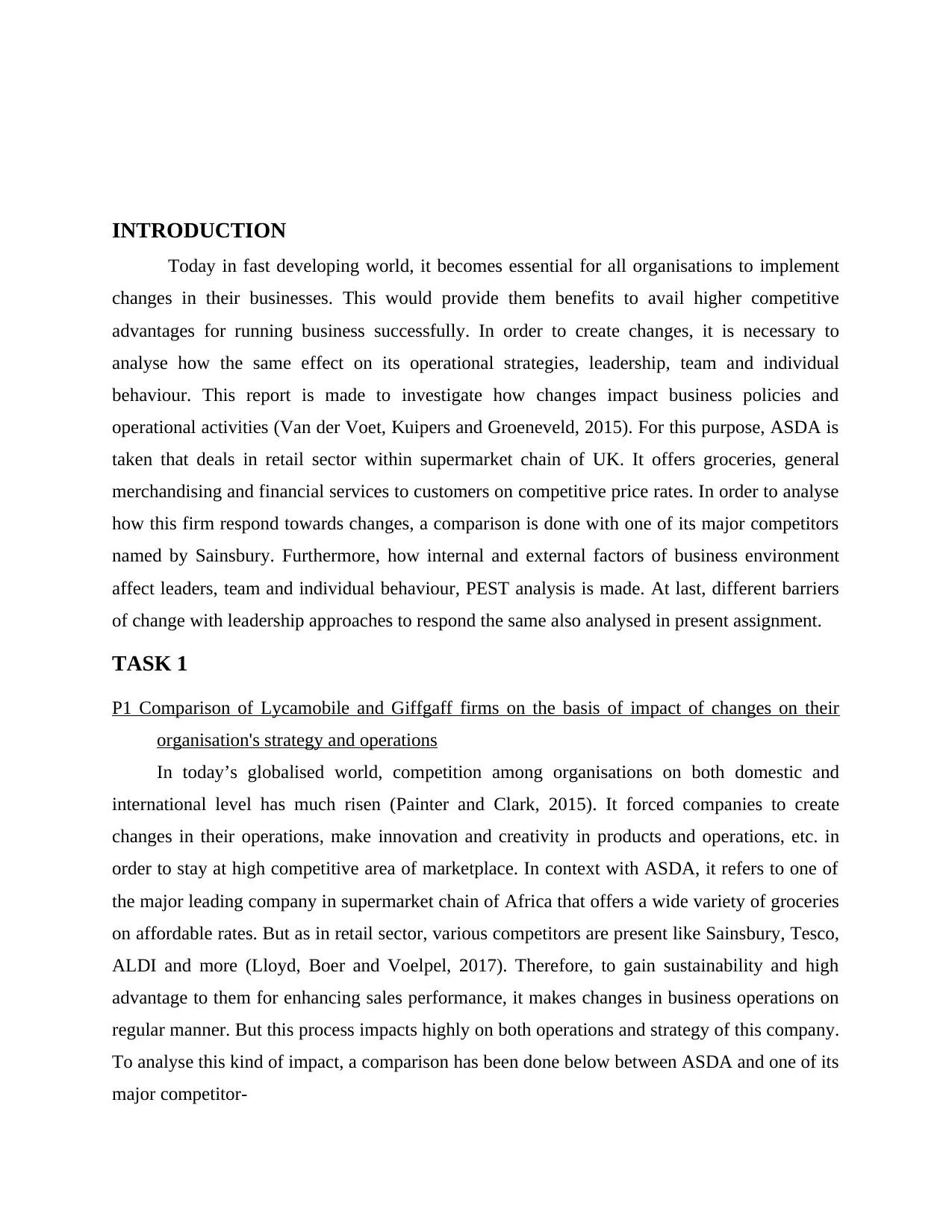
INTRODUCTION
Today in fast developing world, it becomes essential for all organisations to implement
changes in their businesses. This would provide them benefits to avail higher competitive
advantages for running business successfully. In order to create changes, it is necessary to
analyse how the same effect on its operational strategies, leadership, team and individual
behaviour. This report is made to investigate how changes impact business policies and
operational activities (Van der Voet, Kuipers and Groeneveld, 2015). For this purpose, ASDA is
taken that deals in retail sector within supermarket chain of UK. It offers groceries, general
merchandising and financial services to customers on competitive price rates. In order to analyse
how this firm respond towards changes, a comparison is done with one of its major competitors
named by Sainsbury. Furthermore, how internal and external factors of business environment
affect leaders, team and individual behaviour, PEST analysis is made. At last, different barriers
of change with leadership approaches to respond the same also analysed in present assignment.
TASK 1
P1 Comparison of Lycamobile and Giffgaff firms on the basis of impact of changes on their
organisation's strategy and operations
In today’s globalised world, competition among organisations on both domestic and
international level has much risen (Painter and Clark, 2015). It forced companies to create
changes in their operations, make innovation and creativity in products and operations, etc. in
order to stay at high competitive area of marketplace. In context with ASDA, it refers to one of
the major leading company in supermarket chain of Africa that offers a wide variety of groceries
on affordable rates. But as in retail sector, various competitors are present like Sainsbury, Tesco,
ALDI and more (Lloyd, Boer and Voelpel, 2017). Therefore, to gain sustainability and high
advantage to them for enhancing sales performance, it makes changes in business operations on
regular manner. But this process impacts highly on both operations and strategy of this company.
To analyse this kind of impact, a comparison has been done below between ASDA and one of its
major competitor-
Today in fast developing world, it becomes essential for all organisations to implement
changes in their businesses. This would provide them benefits to avail higher competitive
advantages for running business successfully. In order to create changes, it is necessary to
analyse how the same effect on its operational strategies, leadership, team and individual
behaviour. This report is made to investigate how changes impact business policies and
operational activities (Van der Voet, Kuipers and Groeneveld, 2015). For this purpose, ASDA is
taken that deals in retail sector within supermarket chain of UK. It offers groceries, general
merchandising and financial services to customers on competitive price rates. In order to analyse
how this firm respond towards changes, a comparison is done with one of its major competitors
named by Sainsbury. Furthermore, how internal and external factors of business environment
affect leaders, team and individual behaviour, PEST analysis is made. At last, different barriers
of change with leadership approaches to respond the same also analysed in present assignment.
TASK 1
P1 Comparison of Lycamobile and Giffgaff firms on the basis of impact of changes on their
organisation's strategy and operations
In today’s globalised world, competition among organisations on both domestic and
international level has much risen (Painter and Clark, 2015). It forced companies to create
changes in their operations, make innovation and creativity in products and operations, etc. in
order to stay at high competitive area of marketplace. In context with ASDA, it refers to one of
the major leading company in supermarket chain of Africa that offers a wide variety of groceries
on affordable rates. But as in retail sector, various competitors are present like Sainsbury, Tesco,
ALDI and more (Lloyd, Boer and Voelpel, 2017). Therefore, to gain sustainability and high
advantage to them for enhancing sales performance, it makes changes in business operations on
regular manner. But this process impacts highly on both operations and strategy of this company.
To analyse this kind of impact, a comparison has been done below between ASDA and one of its
major competitor-
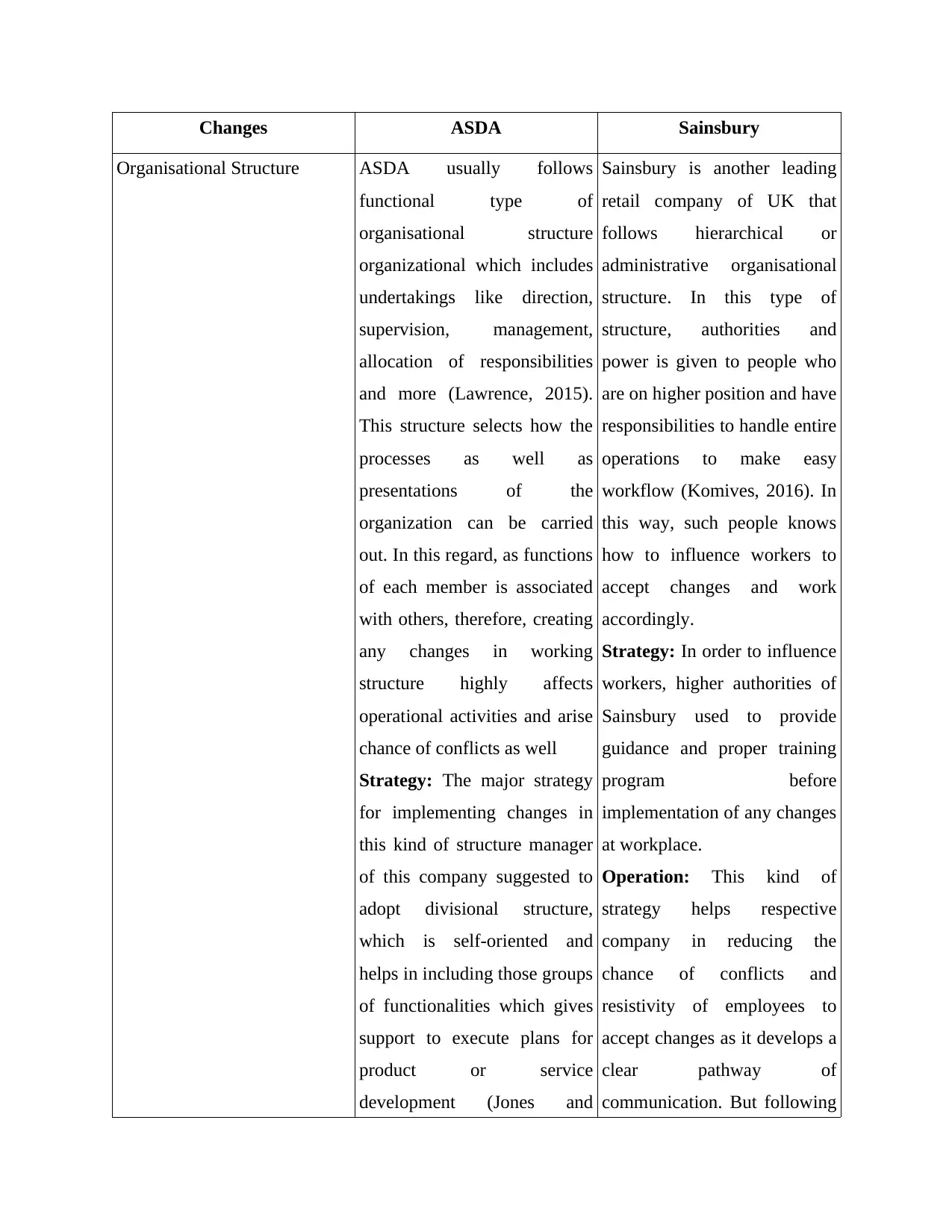
Changes ASDA Sainsbury
Organisational Structure ASDA usually follows
functional type of
organisational structure
organizational which includes
undertakings like direction,
supervision, management,
allocation of responsibilities
and more (Lawrence, 2015).
This structure selects how the
processes as well as
presentations of the
organization can be carried
out. In this regard, as functions
of each member is associated
with others, therefore, creating
any changes in working
structure highly affects
operational activities and arise
chance of conflicts as well
Strategy: The major strategy
for implementing changes in
this kind of structure manager
of this company suggested to
adopt divisional structure,
which is self-oriented and
helps in including those groups
of functionalities which gives
support to execute plans for
product or service
development (Jones and
Sainsbury is another leading
retail company of UK that
follows hierarchical or
administrative organisational
structure. In this type of
structure, authorities and
power is given to people who
are on higher position and have
responsibilities to handle entire
operations to make easy
workflow (Komives, 2016). In
this way, such people knows
how to influence workers to
accept changes and work
accordingly.
Strategy: In order to influence
workers, higher authorities of
Sainsbury used to provide
guidance and proper training
program before
implementation of any changes
at workplace.
Operation: This kind of
strategy helps respective
company in reducing the
chance of conflicts and
resistivity of employees to
accept changes as it develops a
clear pathway of
communication. But following
Organisational Structure ASDA usually follows
functional type of
organisational structure
organizational which includes
undertakings like direction,
supervision, management,
allocation of responsibilities
and more (Lawrence, 2015).
This structure selects how the
processes as well as
presentations of the
organization can be carried
out. In this regard, as functions
of each member is associated
with others, therefore, creating
any changes in working
structure highly affects
operational activities and arise
chance of conflicts as well
Strategy: The major strategy
for implementing changes in
this kind of structure manager
of this company suggested to
adopt divisional structure,
which is self-oriented and
helps in including those groups
of functionalities which gives
support to execute plans for
product or service
development (Jones and
Sainsbury is another leading
retail company of UK that
follows hierarchical or
administrative organisational
structure. In this type of
structure, authorities and
power is given to people who
are on higher position and have
responsibilities to handle entire
operations to make easy
workflow (Komives, 2016). In
this way, such people knows
how to influence workers to
accept changes and work
accordingly.
Strategy: In order to influence
workers, higher authorities of
Sainsbury used to provide
guidance and proper training
program before
implementation of any changes
at workplace.
Operation: This kind of
strategy helps respective
company in reducing the
chance of conflicts and
resistivity of employees to
accept changes as it develops a
clear pathway of
communication. But following
Secure Best Marks with AI Grader
Need help grading? Try our AI Grader for instant feedback on your assignments.
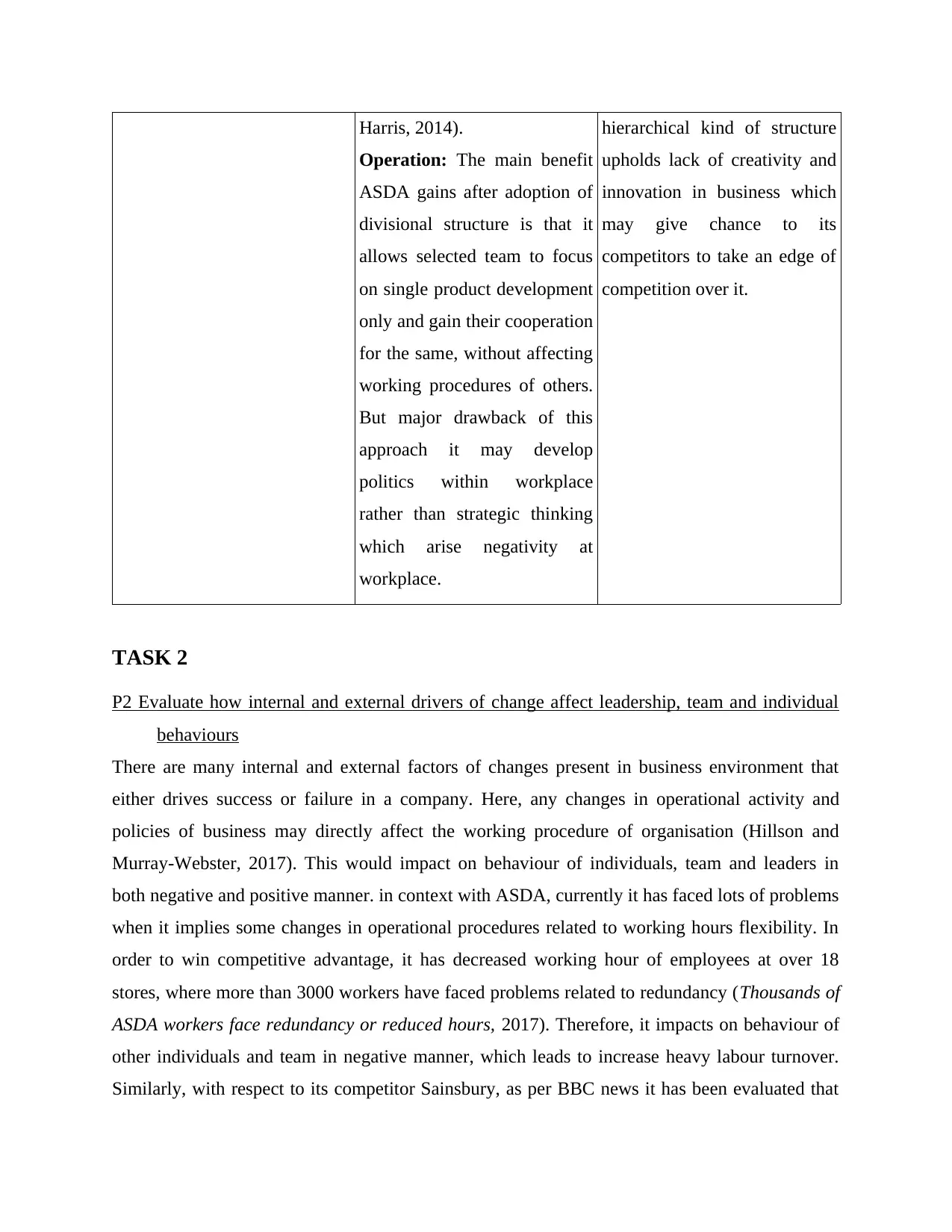
Harris, 2014).
Operation: The main benefit
ASDA gains after adoption of
divisional structure is that it
allows selected team to focus
on single product development
only and gain their cooperation
for the same, without affecting
working procedures of others.
But major drawback of this
approach it may develop
politics within workplace
rather than strategic thinking
which arise negativity at
workplace.
hierarchical kind of structure
upholds lack of creativity and
innovation in business which
may give chance to its
competitors to take an edge of
competition over it.
TASK 2
P2 Evaluate how internal and external drivers of change affect leadership, team and individual
behaviours
There are many internal and external factors of changes present in business environment that
either drives success or failure in a company. Here, any changes in operational activity and
policies of business may directly affect the working procedure of organisation (Hillson and
Murray-Webster, 2017). This would impact on behaviour of individuals, team and leaders in
both negative and positive manner. in context with ASDA, currently it has faced lots of problems
when it implies some changes in operational procedures related to working hours flexibility. In
order to win competitive advantage, it has decreased working hour of employees at over 18
stores, where more than 3000 workers have faced problems related to redundancy (Thousands of
ASDA workers face redundancy or reduced hours, 2017). Therefore, it impacts on behaviour of
other individuals and team in negative manner, which leads to increase heavy labour turnover.
Similarly, with respect to its competitor Sainsbury, as per BBC news it has been evaluated that
Operation: The main benefit
ASDA gains after adoption of
divisional structure is that it
allows selected team to focus
on single product development
only and gain their cooperation
for the same, without affecting
working procedures of others.
But major drawback of this
approach it may develop
politics within workplace
rather than strategic thinking
which arise negativity at
workplace.
hierarchical kind of structure
upholds lack of creativity and
innovation in business which
may give chance to its
competitors to take an edge of
competition over it.
TASK 2
P2 Evaluate how internal and external drivers of change affect leadership, team and individual
behaviours
There are many internal and external factors of changes present in business environment that
either drives success or failure in a company. Here, any changes in operational activity and
policies of business may directly affect the working procedure of organisation (Hillson and
Murray-Webster, 2017). This would impact on behaviour of individuals, team and leaders in
both negative and positive manner. in context with ASDA, currently it has faced lots of problems
when it implies some changes in operational procedures related to working hours flexibility. In
order to win competitive advantage, it has decreased working hour of employees at over 18
stores, where more than 3000 workers have faced problems related to redundancy (Thousands of
ASDA workers face redundancy or reduced hours, 2017). Therefore, it impacts on behaviour of
other individuals and team in negative manner, which leads to increase heavy labour turnover.
Similarly, with respect to its competitor Sainsbury, as per BBC news it has been evaluated that
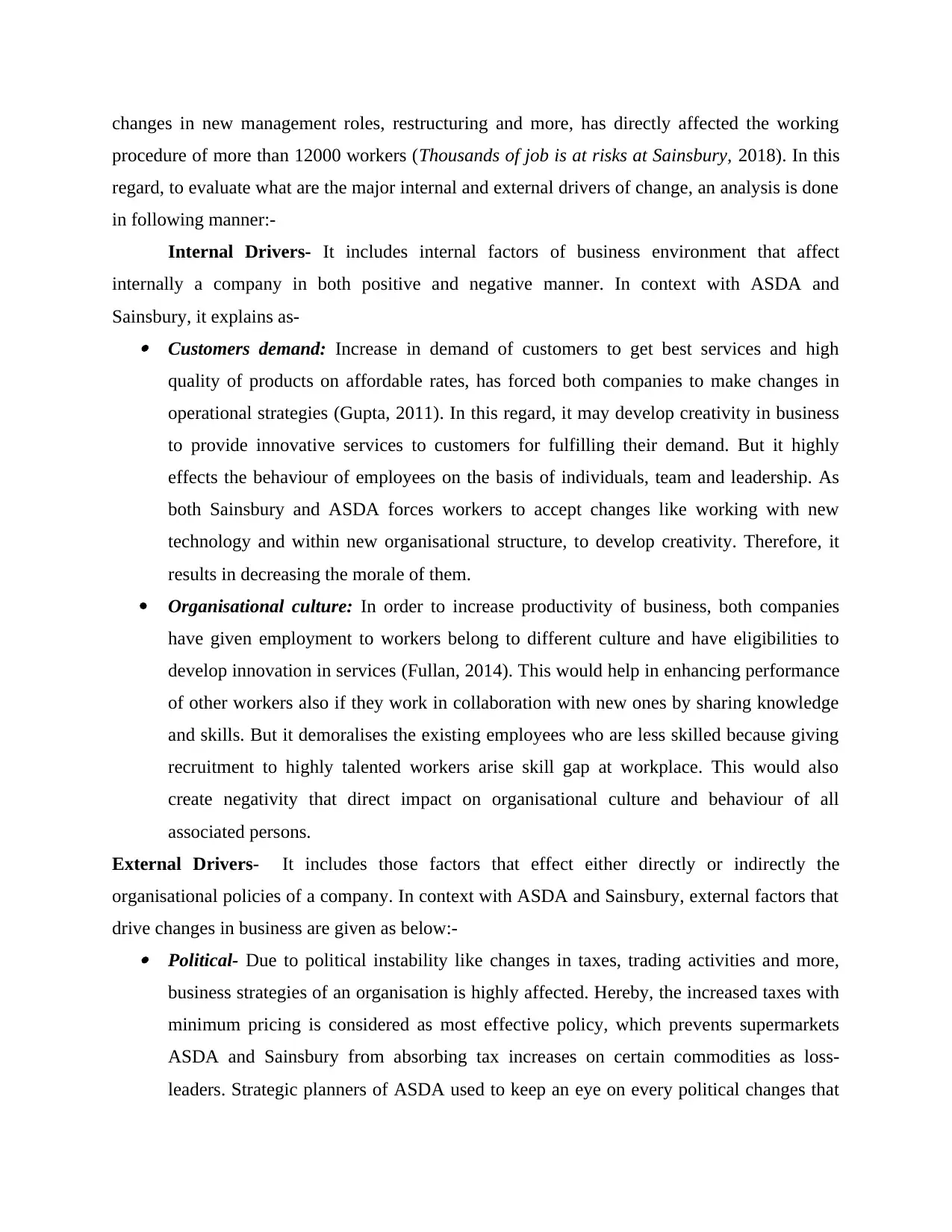
changes in new management roles, restructuring and more, has directly affected the working
procedure of more than 12000 workers (Thousands of job is at risks at Sainsbury, 2018). In this
regard, to evaluate what are the major internal and external drivers of change, an analysis is done
in following manner:-
Internal Drivers- It includes internal factors of business environment that affect
internally a company in both positive and negative manner. In context with ASDA and
Sainsbury, it explains as- Customers demand: Increase in demand of customers to get best services and high
quality of products on affordable rates, has forced both companies to make changes in
operational strategies (Gupta, 2011). In this regard, it may develop creativity in business
to provide innovative services to customers for fulfilling their demand. But it highly
effects the behaviour of employees on the basis of individuals, team and leadership. As
both Sainsbury and ASDA forces workers to accept changes like working with new
technology and within new organisational structure, to develop creativity. Therefore, it
results in decreasing the morale of them.
Organisational culture: In order to increase productivity of business, both companies
have given employment to workers belong to different culture and have eligibilities to
develop innovation in services (Fullan, 2014). This would help in enhancing performance
of other workers also if they work in collaboration with new ones by sharing knowledge
and skills. But it demoralises the existing employees who are less skilled because giving
recruitment to highly talented workers arise skill gap at workplace. This would also
create negativity that direct impact on organisational culture and behaviour of all
associated persons.
External Drivers- It includes those factors that effect either directly or indirectly the
organisational policies of a company. In context with ASDA and Sainsbury, external factors that
drive changes in business are given as below:- Political- Due to political instability like changes in taxes, trading activities and more,
business strategies of an organisation is highly affected. Hereby, the increased taxes with
minimum pricing is considered as most effective policy, which prevents supermarkets
ASDA and Sainsbury from absorbing tax increases on certain commodities as loss-
leaders. Strategic planners of ASDA used to keep an eye on every political changes that
procedure of more than 12000 workers (Thousands of job is at risks at Sainsbury, 2018). In this
regard, to evaluate what are the major internal and external drivers of change, an analysis is done
in following manner:-
Internal Drivers- It includes internal factors of business environment that affect
internally a company in both positive and negative manner. In context with ASDA and
Sainsbury, it explains as- Customers demand: Increase in demand of customers to get best services and high
quality of products on affordable rates, has forced both companies to make changes in
operational strategies (Gupta, 2011). In this regard, it may develop creativity in business
to provide innovative services to customers for fulfilling their demand. But it highly
effects the behaviour of employees on the basis of individuals, team and leadership. As
both Sainsbury and ASDA forces workers to accept changes like working with new
technology and within new organisational structure, to develop creativity. Therefore, it
results in decreasing the morale of them.
Organisational culture: In order to increase productivity of business, both companies
have given employment to workers belong to different culture and have eligibilities to
develop innovation in services (Fullan, 2014). This would help in enhancing performance
of other workers also if they work in collaboration with new ones by sharing knowledge
and skills. But it demoralises the existing employees who are less skilled because giving
recruitment to highly talented workers arise skill gap at workplace. This would also
create negativity that direct impact on organisational culture and behaviour of all
associated persons.
External Drivers- It includes those factors that effect either directly or indirectly the
organisational policies of a company. In context with ASDA and Sainsbury, external factors that
drive changes in business are given as below:- Political- Due to political instability like changes in taxes, trading activities and more,
business strategies of an organisation is highly affected. Hereby, the increased taxes with
minimum pricing is considered as most effective policy, which prevents supermarkets
ASDA and Sainsbury from absorbing tax increases on certain commodities as loss-
leaders. Strategic planners of ASDA used to keep an eye on every political changes that

impact it on its policy and forced to keep prices (Fragouli and Ibidapo, 2015). This would
help in running business effectively by initiating changes. But it arise issues for workers
as they have to shift their working hours and other, as per demand of business. Therefore,
to handle this situation, leaders have to adopt new style of leadership like democratic to
influence workers to accept changes and turn negative behaviour of team members into
positive. Economical- With changes in budget looming as well as coalition economic policy
forced companies to make changes in pricing strategies as per fluctuations in inflation or
deflation rate. In this regard, Asda prefers to adopt approaches implemented by its major
competitors Tesco and Sainsbury related to tax avoidance, functioning on the basis of
monopolistic, depriving farmers of a livelihood and more, which may drive local
companies out of communities low (Doppelt, 2017). But due to increase in pressure on
UK Government to bring a stricter approach for companies to competition in order to
bring them under control, has create a serious implication for ASDA and other
supermarket chains related to long term operations. So, it affects entire operations of
respective company that affect human behaviour as well on the basis of individual, team
and leadership when company is not in position to earn required profitability.
Social- Changes in social trends lead to affect demand of customers for Asda’s product as
well as availability and willingness of workers to work for it (Anderson, 2016). In this
regard, Asda have started to make changes in production and supply, due to growing
demand of organic food and high quality of its non-food products.
Technological- this factor helps in reducing costs, improving quality and developing
innovation in a business. These developments can provide benefit to ASDA and
Sainsbury to primary focus on saving money and keeping costs low. But implementation
of new technology like AI and cloud computing, arise threat of employee resistivity
because it directly affect their working procedures (Alavi and Gill, 2017). Therefore,
leaders have to provide effective training to workers by analysing their weak points and
increase capabilities of them to work with new technology.
P3 Methods for reducing negative impact of change
Changes in organisational rules, policies and operational activities play a crucial role in
driving success in a business. It helps in creating modification in business for product and service
help in running business effectively by initiating changes. But it arise issues for workers
as they have to shift their working hours and other, as per demand of business. Therefore,
to handle this situation, leaders have to adopt new style of leadership like democratic to
influence workers to accept changes and turn negative behaviour of team members into
positive. Economical- With changes in budget looming as well as coalition economic policy
forced companies to make changes in pricing strategies as per fluctuations in inflation or
deflation rate. In this regard, Asda prefers to adopt approaches implemented by its major
competitors Tesco and Sainsbury related to tax avoidance, functioning on the basis of
monopolistic, depriving farmers of a livelihood and more, which may drive local
companies out of communities low (Doppelt, 2017). But due to increase in pressure on
UK Government to bring a stricter approach for companies to competition in order to
bring them under control, has create a serious implication for ASDA and other
supermarket chains related to long term operations. So, it affects entire operations of
respective company that affect human behaviour as well on the basis of individual, team
and leadership when company is not in position to earn required profitability.
Social- Changes in social trends lead to affect demand of customers for Asda’s product as
well as availability and willingness of workers to work for it (Anderson, 2016). In this
regard, Asda have started to make changes in production and supply, due to growing
demand of organic food and high quality of its non-food products.
Technological- this factor helps in reducing costs, improving quality and developing
innovation in a business. These developments can provide benefit to ASDA and
Sainsbury to primary focus on saving money and keeping costs low. But implementation
of new technology like AI and cloud computing, arise threat of employee resistivity
because it directly affect their working procedures (Alavi and Gill, 2017). Therefore,
leaders have to provide effective training to workers by analysing their weak points and
increase capabilities of them to work with new technology.
P3 Methods for reducing negative impact of change
Changes in organisational rules, policies and operational activities play a crucial role in
driving success in a business. It helps in creating modification in business for product and service
Paraphrase This Document
Need a fresh take? Get an instant paraphrase of this document with our AI Paraphraser
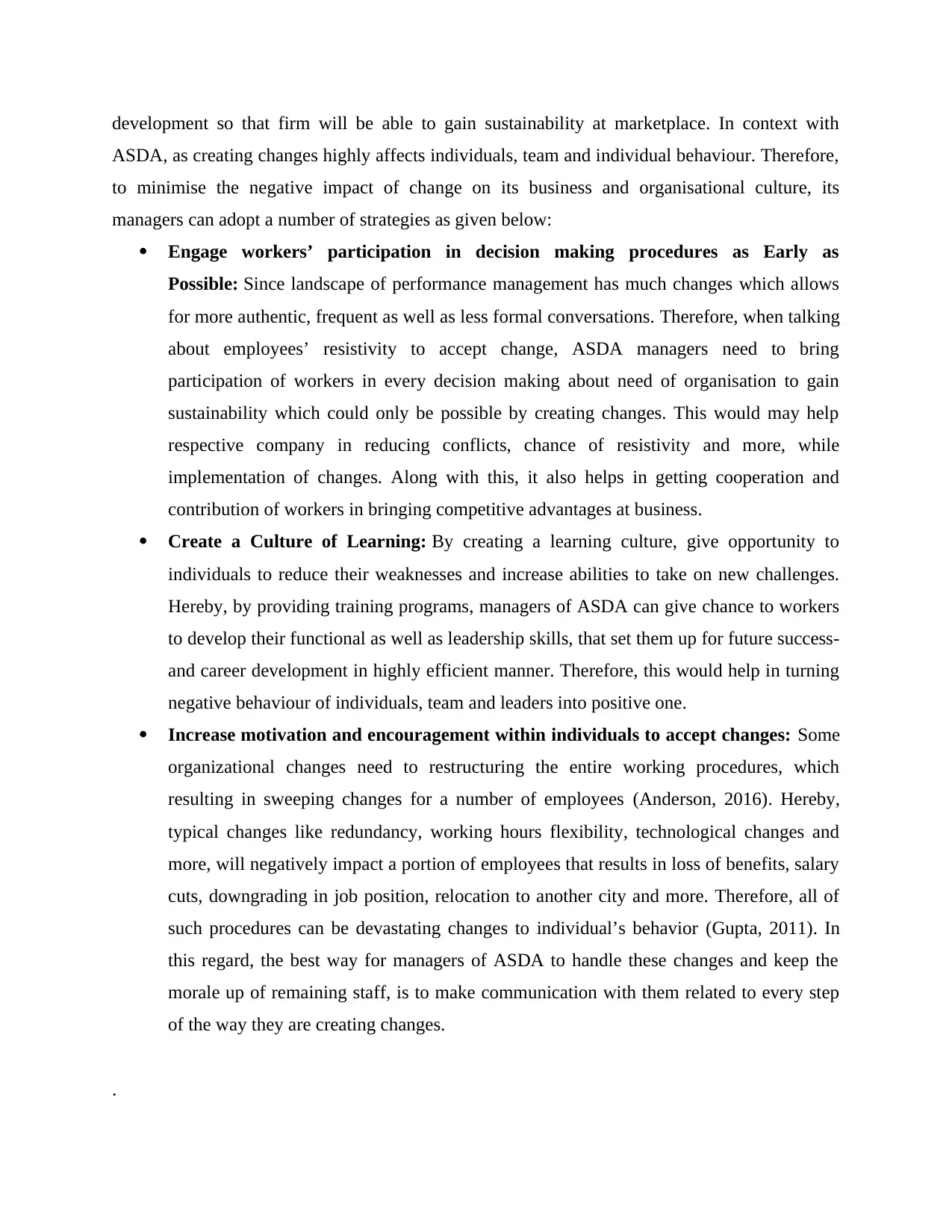
development so that firm will be able to gain sustainability at marketplace. In context with
ASDA, as creating changes highly affects individuals, team and individual behaviour. Therefore,
to minimise the negative impact of change on its business and organisational culture, its
managers can adopt a number of strategies as given below:
Engage workers’ participation in decision making procedures as Early as
Possible: Since landscape of performance management has much changes which allows
for more authentic, frequent as well as less formal conversations. Therefore, when talking
about employees’ resistivity to accept change, ASDA managers need to bring
participation of workers in every decision making about need of organisation to gain
sustainability which could only be possible by creating changes. This would may help
respective company in reducing conflicts, chance of resistivity and more, while
implementation of changes. Along with this, it also helps in getting cooperation and
contribution of workers in bringing competitive advantages at business.
Create a Culture of Learning: By creating a learning culture, give opportunity to
individuals to reduce their weaknesses and increase abilities to take on new challenges.
Hereby, by providing training programs, managers of ASDA can give chance to workers
to develop their functional as well as leadership skills, that set them up for future success-
and career development in highly efficient manner. Therefore, this would help in turning
negative behaviour of individuals, team and leaders into positive one.
Increase motivation and encouragement within individuals to accept changes: Some
organizational changes need to restructuring the entire working procedures, which
resulting in sweeping changes for a number of employees (Anderson, 2016). Hereby,
typical changes like redundancy, working hours flexibility, technological changes and
more, will negatively impact a portion of employees that results in loss of benefits, salary
cuts, downgrading in job position, relocation to another city and more. Therefore, all of
such procedures can be devastating changes to individual’s behavior (Gupta, 2011). In
this regard, the best way for managers of ASDA to handle these changes and keep the
morale up of remaining staff, is to make communication with them related to every step
of the way they are creating changes.
.
ASDA, as creating changes highly affects individuals, team and individual behaviour. Therefore,
to minimise the negative impact of change on its business and organisational culture, its
managers can adopt a number of strategies as given below:
Engage workers’ participation in decision making procedures as Early as
Possible: Since landscape of performance management has much changes which allows
for more authentic, frequent as well as less formal conversations. Therefore, when talking
about employees’ resistivity to accept change, ASDA managers need to bring
participation of workers in every decision making about need of organisation to gain
sustainability which could only be possible by creating changes. This would may help
respective company in reducing conflicts, chance of resistivity and more, while
implementation of changes. Along with this, it also helps in getting cooperation and
contribution of workers in bringing competitive advantages at business.
Create a Culture of Learning: By creating a learning culture, give opportunity to
individuals to reduce their weaknesses and increase abilities to take on new challenges.
Hereby, by providing training programs, managers of ASDA can give chance to workers
to develop their functional as well as leadership skills, that set them up for future success-
and career development in highly efficient manner. Therefore, this would help in turning
negative behaviour of individuals, team and leaders into positive one.
Increase motivation and encouragement within individuals to accept changes: Some
organizational changes need to restructuring the entire working procedures, which
resulting in sweeping changes for a number of employees (Anderson, 2016). Hereby,
typical changes like redundancy, working hours flexibility, technological changes and
more, will negatively impact a portion of employees that results in loss of benefits, salary
cuts, downgrading in job position, relocation to another city and more. Therefore, all of
such procedures can be devastating changes to individual’s behavior (Gupta, 2011). In
this regard, the best way for managers of ASDA to handle these changes and keep the
morale up of remaining staff, is to make communication with them related to every step
of the way they are creating changes.
.
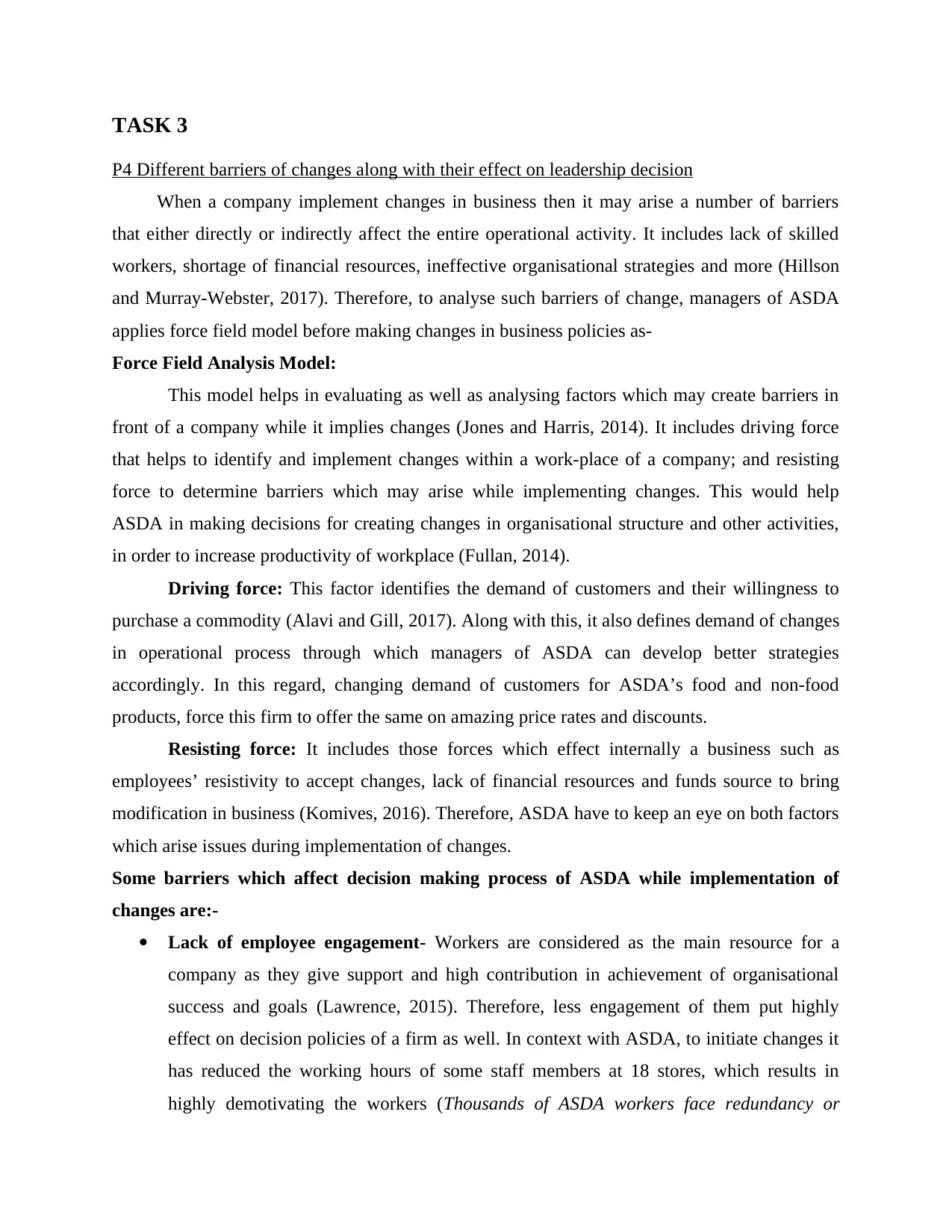
TASK 3
P4 Different barriers of changes along with their effect on leadership decision
When a company implement changes in business then it may arise a number of barriers
that either directly or indirectly affect the entire operational activity. It includes lack of skilled
workers, shortage of financial resources, ineffective organisational strategies and more (Hillson
and Murray-Webster, 2017). Therefore, to analyse such barriers of change, managers of ASDA
applies force field model before making changes in business policies as-
Force Field Analysis Model:
This model helps in evaluating as well as analysing factors which may create barriers in
front of a company while it implies changes (Jones and Harris, 2014). It includes driving force
that helps to identify and implement changes within a work-place of a company; and resisting
force to determine barriers which may arise while implementing changes. This would help
ASDA in making decisions for creating changes in organisational structure and other activities,
in order to increase productivity of workplace (Fullan, 2014).
Driving force: This factor identifies the demand of customers and their willingness to
purchase a commodity (Alavi and Gill, 2017). Along with this, it also defines demand of changes
in operational process through which managers of ASDA can develop better strategies
accordingly. In this regard, changing demand of customers for ASDA’s food and non-food
products, force this firm to offer the same on amazing price rates and discounts.
Resisting force: It includes those forces which effect internally a business such as
employees’ resistivity to accept changes, lack of financial resources and funds source to bring
modification in business (Komives, 2016). Therefore, ASDA have to keep an eye on both factors
which arise issues during implementation of changes.
Some barriers which affect decision making process of ASDA while implementation of
changes are:-
Lack of employee engagement- Workers are considered as the main resource for a
company as they give support and high contribution in achievement of organisational
success and goals (Lawrence, 2015). Therefore, less engagement of them put highly
effect on decision policies of a firm as well. In context with ASDA, to initiate changes it
has reduced the working hours of some staff members at 18 stores, which results in
highly demotivating the workers (Thousands of ASDA workers face redundancy or
P4 Different barriers of changes along with their effect on leadership decision
When a company implement changes in business then it may arise a number of barriers
that either directly or indirectly affect the entire operational activity. It includes lack of skilled
workers, shortage of financial resources, ineffective organisational strategies and more (Hillson
and Murray-Webster, 2017). Therefore, to analyse such barriers of change, managers of ASDA
applies force field model before making changes in business policies as-
Force Field Analysis Model:
This model helps in evaluating as well as analysing factors which may create barriers in
front of a company while it implies changes (Jones and Harris, 2014). It includes driving force
that helps to identify and implement changes within a work-place of a company; and resisting
force to determine barriers which may arise while implementing changes. This would help
ASDA in making decisions for creating changes in organisational structure and other activities,
in order to increase productivity of workplace (Fullan, 2014).
Driving force: This factor identifies the demand of customers and their willingness to
purchase a commodity (Alavi and Gill, 2017). Along with this, it also defines demand of changes
in operational process through which managers of ASDA can develop better strategies
accordingly. In this regard, changing demand of customers for ASDA’s food and non-food
products, force this firm to offer the same on amazing price rates and discounts.
Resisting force: It includes those forces which effect internally a business such as
employees’ resistivity to accept changes, lack of financial resources and funds source to bring
modification in business (Komives, 2016). Therefore, ASDA have to keep an eye on both factors
which arise issues during implementation of changes.
Some barriers which affect decision making process of ASDA while implementation of
changes are:-
Lack of employee engagement- Workers are considered as the main resource for a
company as they give support and high contribution in achievement of organisational
success and goals (Lawrence, 2015). Therefore, less engagement of them put highly
effect on decision policies of a firm as well. In context with ASDA, to initiate changes it
has reduced the working hours of some staff members at 18 stores, which results in
highly demotivating the workers (Thousands of ASDA workers face redundancy or
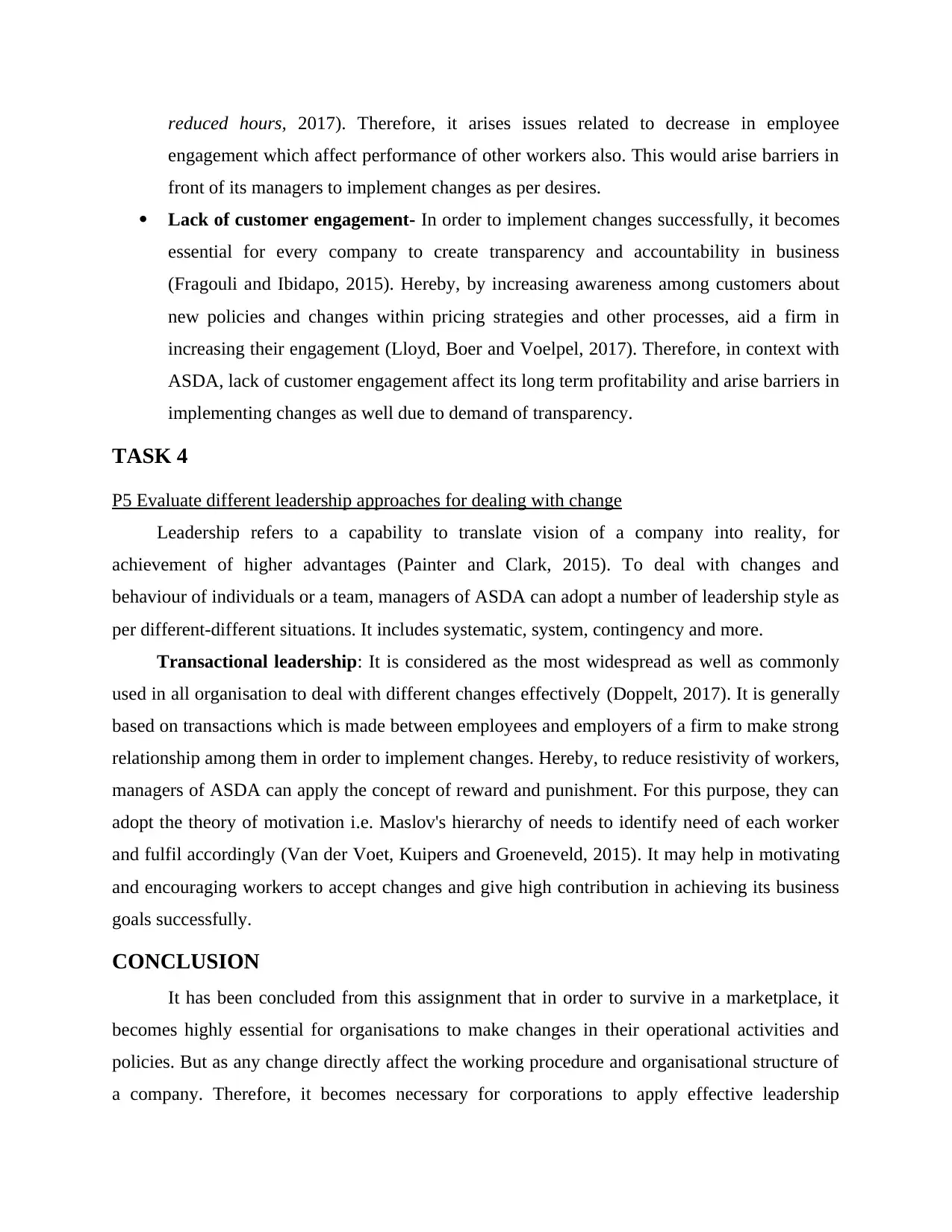
reduced hours, 2017). Therefore, it arises issues related to decrease in employee
engagement which affect performance of other workers also. This would arise barriers in
front of its managers to implement changes as per desires.
Lack of customer engagement- In order to implement changes successfully, it becomes
essential for every company to create transparency and accountability in business
(Fragouli and Ibidapo, 2015). Hereby, by increasing awareness among customers about
new policies and changes within pricing strategies and other processes, aid a firm in
increasing their engagement (Lloyd, Boer and Voelpel, 2017). Therefore, in context with
ASDA, lack of customer engagement affect its long term profitability and arise barriers in
implementing changes as well due to demand of transparency.
TASK 4
P5 Evaluate different leadership approaches for dealing with change
Leadership refers to a capability to translate vision of a company into reality, for
achievement of higher advantages (Painter and Clark, 2015). To deal with changes and
behaviour of individuals or a team, managers of ASDA can adopt a number of leadership style as
per different-different situations. It includes systematic, system, contingency and more.
Transactional leadership: It is considered as the most widespread as well as commonly
used in all organisation to deal with different changes effectively (Doppelt, 2017). It is generally
based on transactions which is made between employees and employers of a firm to make strong
relationship among them in order to implement changes. Hereby, to reduce resistivity of workers,
managers of ASDA can apply the concept of reward and punishment. For this purpose, they can
adopt the theory of motivation i.e. Maslov's hierarchy of needs to identify need of each worker
and fulfil accordingly (Van der Voet, Kuipers and Groeneveld, 2015). It may help in motivating
and encouraging workers to accept changes and give high contribution in achieving its business
goals successfully.
CONCLUSION
It has been concluded from this assignment that in order to survive in a marketplace, it
becomes highly essential for organisations to make changes in their operational activities and
policies. But as any change directly affect the working procedure and organisational structure of
a company. Therefore, it becomes necessary for corporations to apply effective leadership
engagement which affect performance of other workers also. This would arise barriers in
front of its managers to implement changes as per desires.
Lack of customer engagement- In order to implement changes successfully, it becomes
essential for every company to create transparency and accountability in business
(Fragouli and Ibidapo, 2015). Hereby, by increasing awareness among customers about
new policies and changes within pricing strategies and other processes, aid a firm in
increasing their engagement (Lloyd, Boer and Voelpel, 2017). Therefore, in context with
ASDA, lack of customer engagement affect its long term profitability and arise barriers in
implementing changes as well due to demand of transparency.
TASK 4
P5 Evaluate different leadership approaches for dealing with change
Leadership refers to a capability to translate vision of a company into reality, for
achievement of higher advantages (Painter and Clark, 2015). To deal with changes and
behaviour of individuals or a team, managers of ASDA can adopt a number of leadership style as
per different-different situations. It includes systematic, system, contingency and more.
Transactional leadership: It is considered as the most widespread as well as commonly
used in all organisation to deal with different changes effectively (Doppelt, 2017). It is generally
based on transactions which is made between employees and employers of a firm to make strong
relationship among them in order to implement changes. Hereby, to reduce resistivity of workers,
managers of ASDA can apply the concept of reward and punishment. For this purpose, they can
adopt the theory of motivation i.e. Maslov's hierarchy of needs to identify need of each worker
and fulfil accordingly (Van der Voet, Kuipers and Groeneveld, 2015). It may help in motivating
and encouraging workers to accept changes and give high contribution in achieving its business
goals successfully.
CONCLUSION
It has been concluded from this assignment that in order to survive in a marketplace, it
becomes highly essential for organisations to make changes in their operational activities and
policies. But as any change directly affect the working procedure and organisational structure of
a company. Therefore, it becomes necessary for corporations to apply effective leadership
Secure Best Marks with AI Grader
Need help grading? Try our AI Grader for instant feedback on your assignments.

approaches for influencing workers to accept changes and give contribution in attainment of
business objectives. Along with this, companies also need to analyse certain factors like political
instability, economical fluctuations, lack of unskilled workers etc. that may create barriers in
implementation of changes. This would help in determining strategies by which they can reduce
barriers and achieve business goals more easily.
business objectives. Along with this, companies also need to analyse certain factors like political
instability, economical fluctuations, lack of unskilled workers etc. that may create barriers in
implementation of changes. This would help in determining strategies by which they can reduce
barriers and achieve business goals more easily.

REFERENCES
Books and Journals
Alavi, S. B. and Gill, C., 2017. Leading change authentically: How authentic leaders influence
follower responses to complex change. Journal of Leadership & Organizational Studies.
24(2). pp.157-171.
Anderson, D. L., 2016. Organization development: The process of leading organizational
change. Sage Publications.
Doppelt, B., 2017. Leading change toward sustainability: A change-management guide for
business, government and civil society. Routledge.
Fragouli, E. and Ibidapo, B., 2015. Leading in crisis: Leading organizational change & business
development. International Journal of Information, Business and Management. 7(3).
p.71.
Fullan, M., 2014. Leading in a culture of change personal action guide and workbook. John
Wiley & Sons.
Gupta, P., 2011. Leading innovation change-The Kotter way. International Journal of Innovation
Science. 3(3). pp.141-150.
Hillson, D. and Murray-Webster, R., 2017. Understanding and managing risk attitude.
Routledge.
Jones, M. and Harris, A., 2014. Principals leading successful organisational change: Building
social capital through disciplined professional collaboration. Journal of Organizational
Change Management. 27(3). pp.473-485.
Komives, S. R., 2016. Leadership for a better world: Understanding the social change model of
leadership development. John Wiley & Sons.
Lawrence, P., 2015. Leading change–Insights into how leaders actually approach the challenge
of complexity. Journal of Change Management. 15(3). pp.231-252.
Lloyd, K. J., Boer, D. and Voelpel, S. C., 2017. From listening to leading: Toward an
understanding of supervisor listening within the framework of leader-member exchange
theory. International Journal of Business Communication, 54(4), pp.431-451.
Painter, S. and Clark, C. M., 2015. Leading change: Faculty development through structured
collaboration. International Journal of Doctoral Studies. 10. pp.187-198.
Van der Voet, J., Kuipers, B. and Groeneveld, S., 2015. Held back and pushed forward: leading
change in a complex public sector environment. Journal of Organizational Change
Management. 28(2). pp.290-300.
Online
Thousands of job is at risks at Sainsbury. 2018. [Online] Available through:
<https://www.bbc.com/news/business-42791079>
Thousands of ASDA workers face redundancy or reduced hours. 2017. [Online] Available
through: < https://www.theguardian.com/business/2017/aug/10/asda-workers-face-
redundancy-uk-walmart>
Books and Journals
Alavi, S. B. and Gill, C., 2017. Leading change authentically: How authentic leaders influence
follower responses to complex change. Journal of Leadership & Organizational Studies.
24(2). pp.157-171.
Anderson, D. L., 2016. Organization development: The process of leading organizational
change. Sage Publications.
Doppelt, B., 2017. Leading change toward sustainability: A change-management guide for
business, government and civil society. Routledge.
Fragouli, E. and Ibidapo, B., 2015. Leading in crisis: Leading organizational change & business
development. International Journal of Information, Business and Management. 7(3).
p.71.
Fullan, M., 2014. Leading in a culture of change personal action guide and workbook. John
Wiley & Sons.
Gupta, P., 2011. Leading innovation change-The Kotter way. International Journal of Innovation
Science. 3(3). pp.141-150.
Hillson, D. and Murray-Webster, R., 2017. Understanding and managing risk attitude.
Routledge.
Jones, M. and Harris, A., 2014. Principals leading successful organisational change: Building
social capital through disciplined professional collaboration. Journal of Organizational
Change Management. 27(3). pp.473-485.
Komives, S. R., 2016. Leadership for a better world: Understanding the social change model of
leadership development. John Wiley & Sons.
Lawrence, P., 2015. Leading change–Insights into how leaders actually approach the challenge
of complexity. Journal of Change Management. 15(3). pp.231-252.
Lloyd, K. J., Boer, D. and Voelpel, S. C., 2017. From listening to leading: Toward an
understanding of supervisor listening within the framework of leader-member exchange
theory. International Journal of Business Communication, 54(4), pp.431-451.
Painter, S. and Clark, C. M., 2015. Leading change: Faculty development through structured
collaboration. International Journal of Doctoral Studies. 10. pp.187-198.
Van der Voet, J., Kuipers, B. and Groeneveld, S., 2015. Held back and pushed forward: leading
change in a complex public sector environment. Journal of Organizational Change
Management. 28(2). pp.290-300.
Online
Thousands of job is at risks at Sainsbury. 2018. [Online] Available through:
<https://www.bbc.com/news/business-42791079>
Thousands of ASDA workers face redundancy or reduced hours. 2017. [Online] Available
through: < https://www.theguardian.com/business/2017/aug/10/asda-workers-face-
redundancy-uk-walmart>
1 out of 12
Related Documents
Your All-in-One AI-Powered Toolkit for Academic Success.
+13062052269
info@desklib.com
Available 24*7 on WhatsApp / Email
![[object Object]](/_next/static/media/star-bottom.7253800d.svg)
Unlock your academic potential
© 2024 | Zucol Services PVT LTD | All rights reserved.




